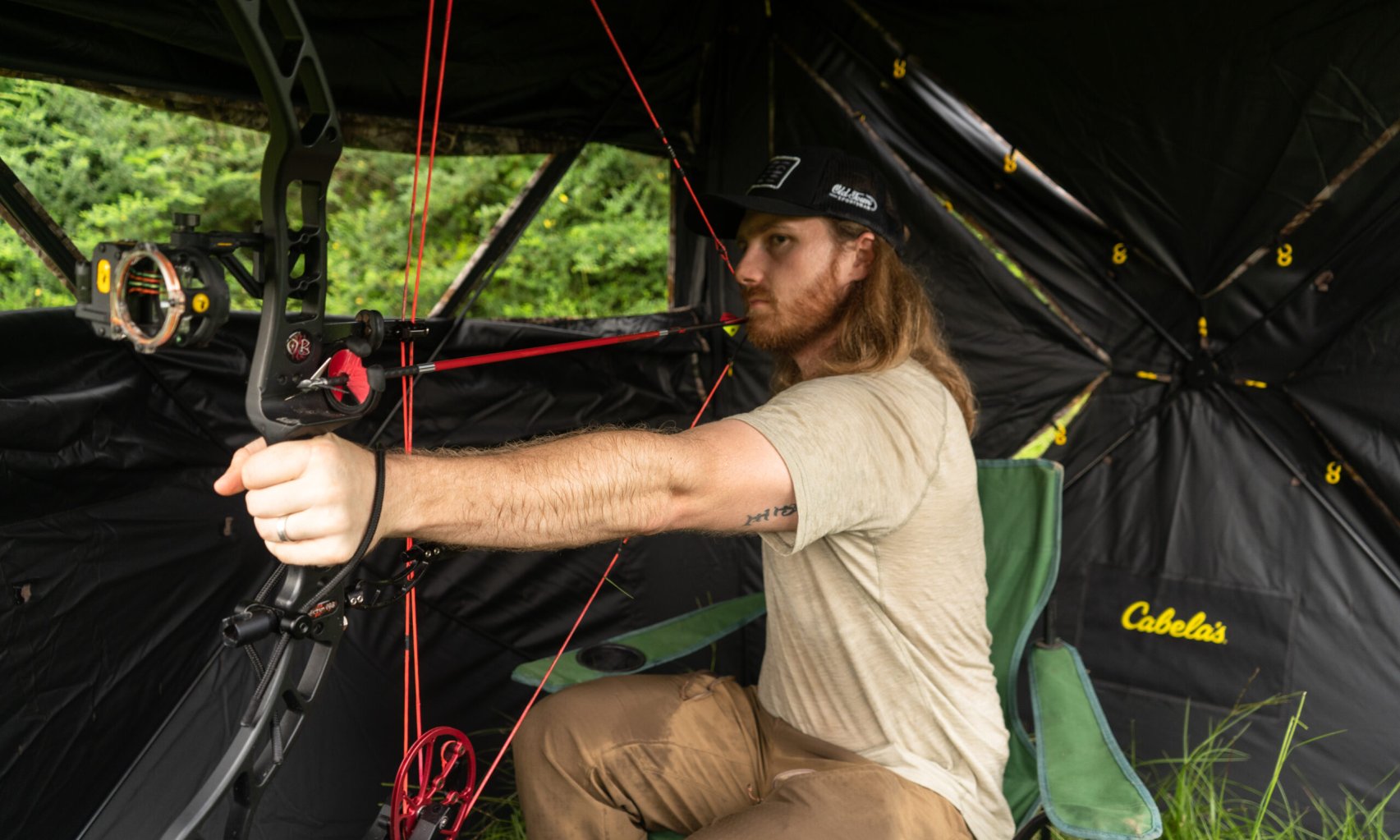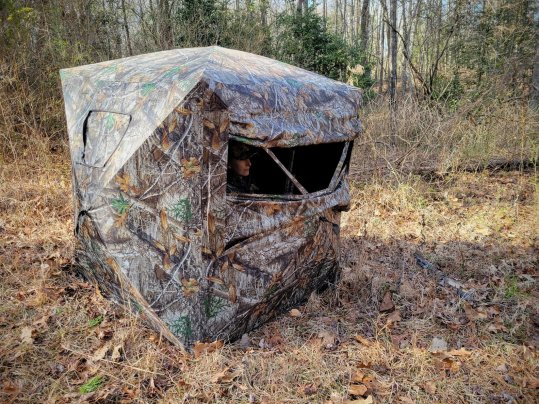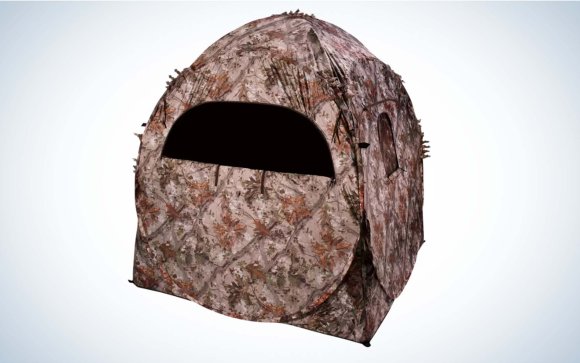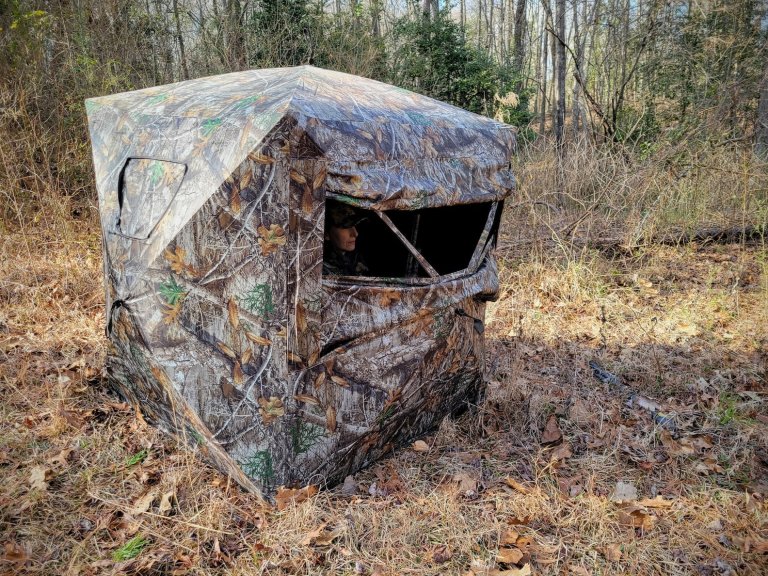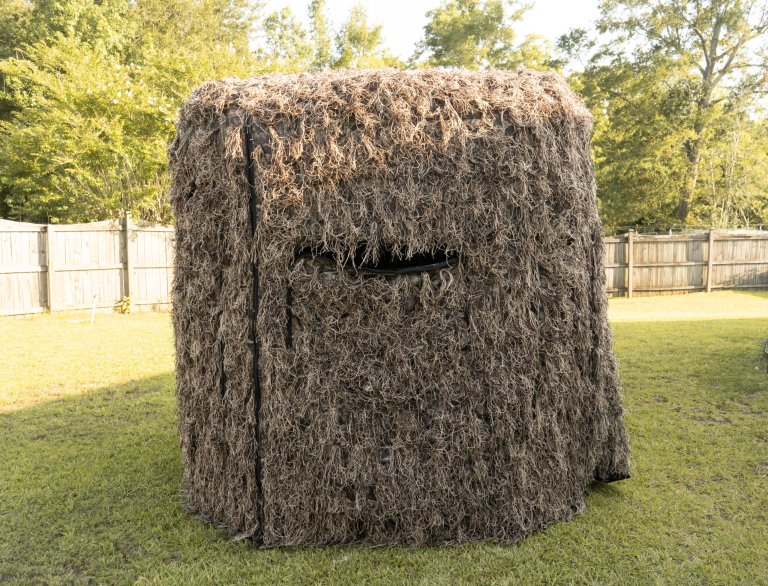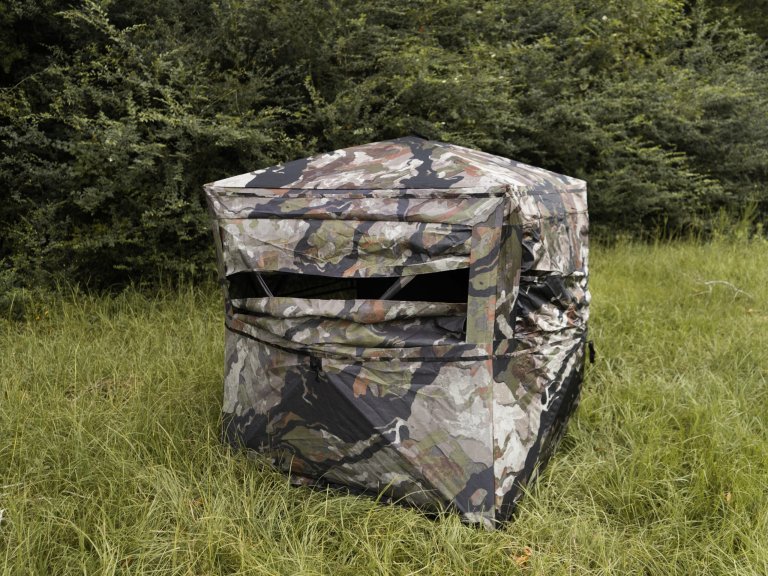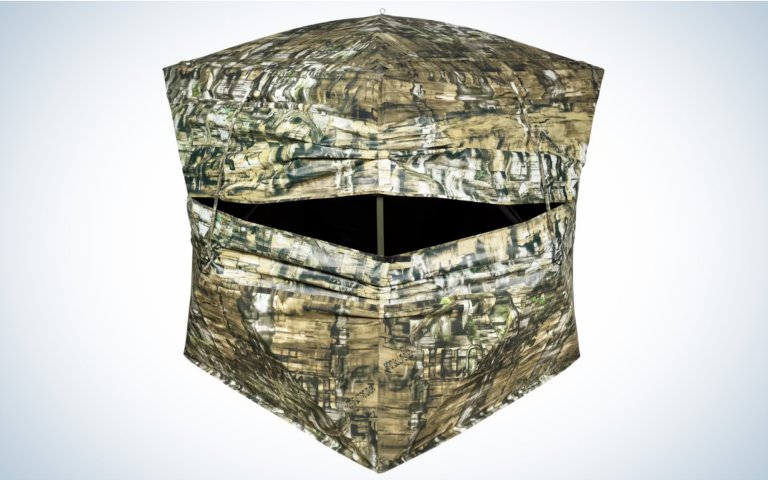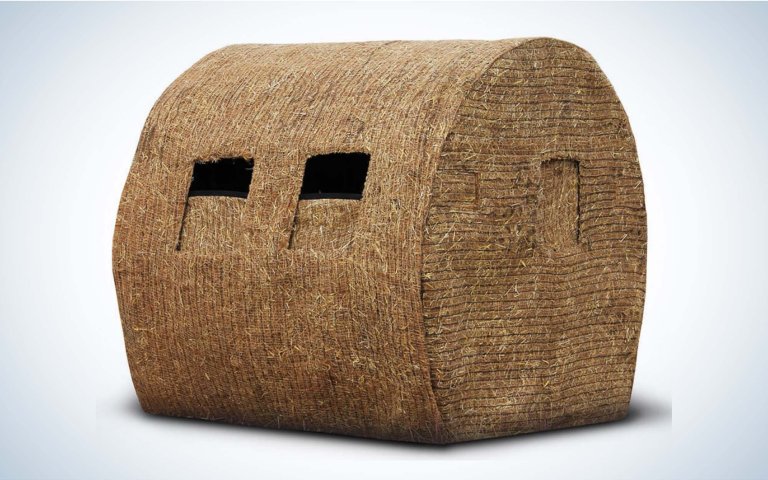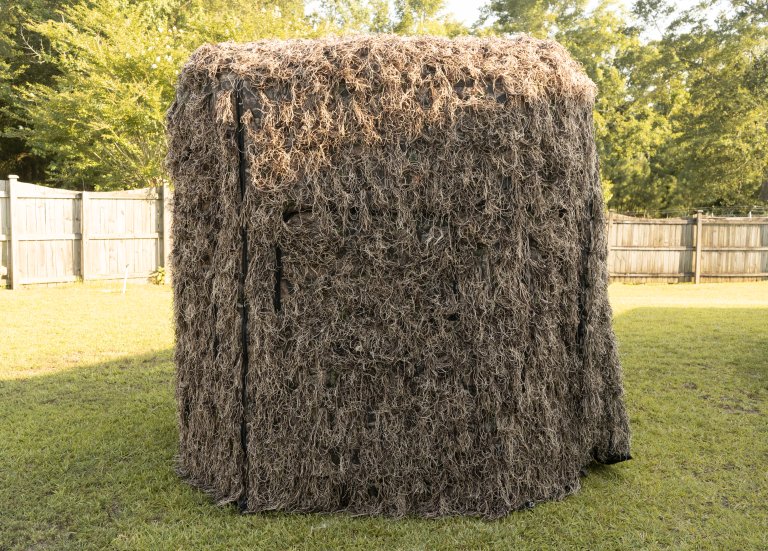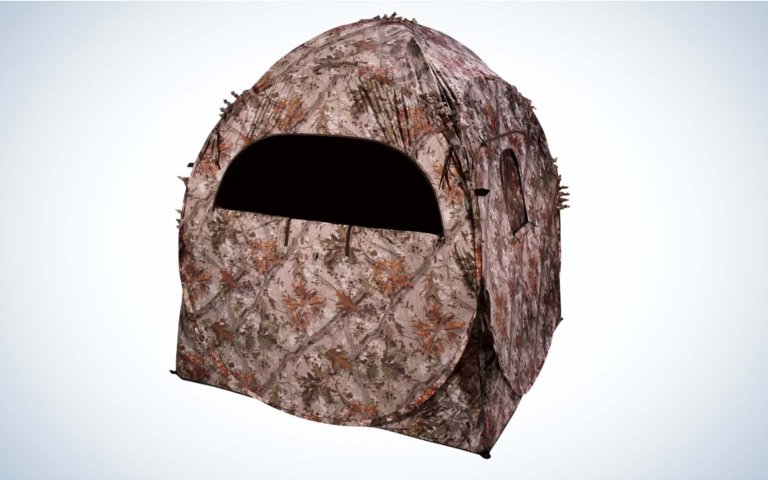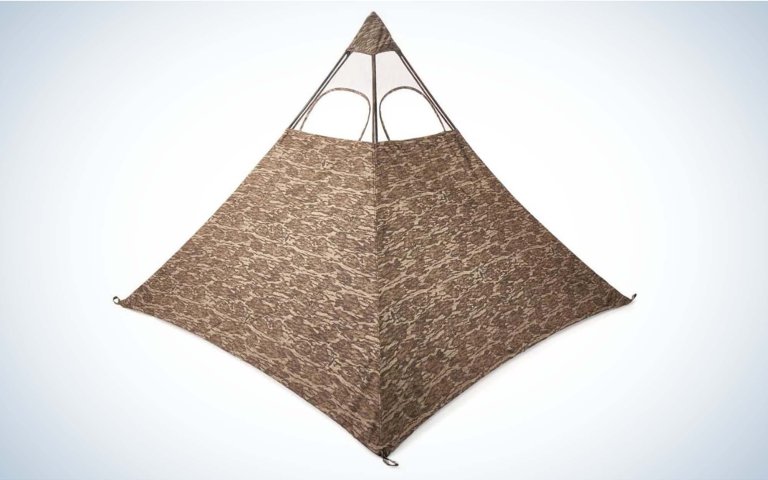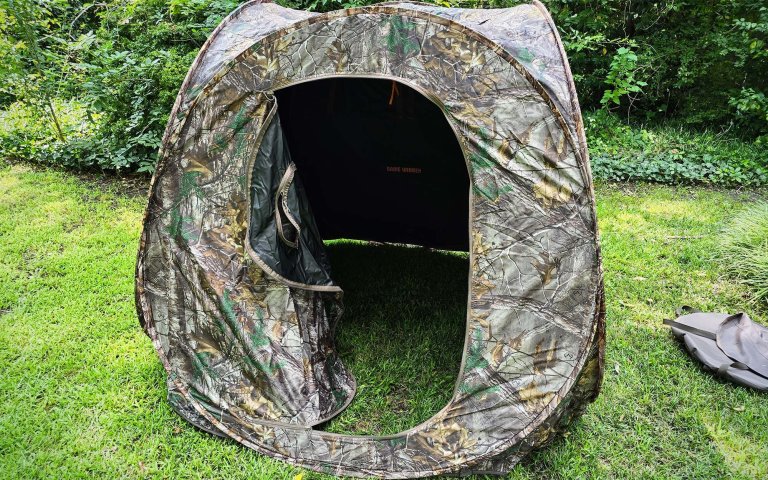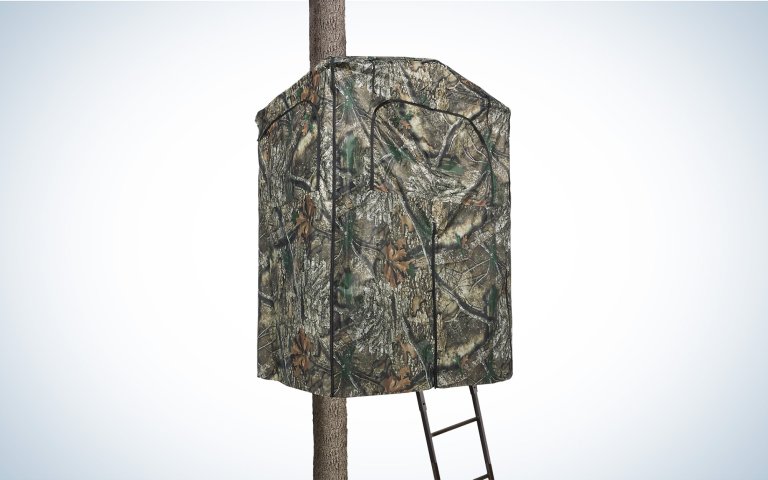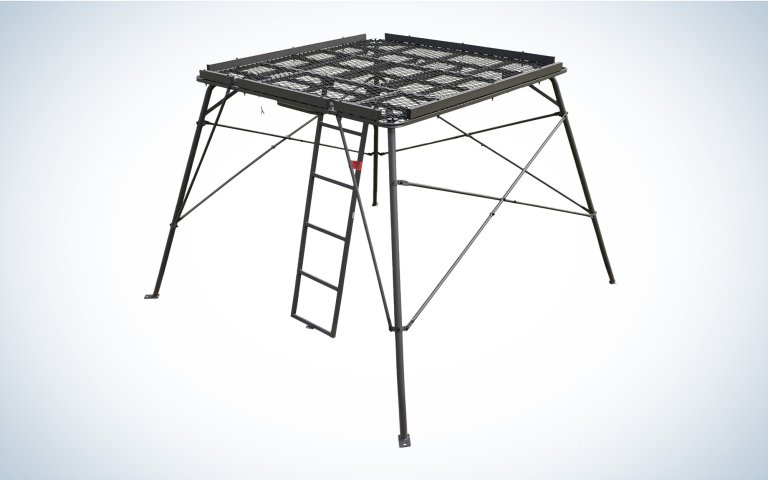We may earn revenue from the products available on this page and participate in affiliate programs. Learn More ›
If it weren’t for hunting blinds, I might not have killed my first deer as a kid. I was barely a teen, and had just started hunting on my own. I was anything but stealthy. My dad made the wise decision to station me in a blind, and I made a lucky offhand shot on a basket rack eight. Since then, hunting blinds haven’t been my first choice when it comes to setups, but I have used them strategically when cover and tree stand options were slim. I’ve also used them to introduce younger siblings or new hunters to the sport.
Today, there’s a wide variety of hunting blind styles that are useful to veteran hunters and new hunters alike. I reviewed the best hunting blinds for a bunch of different strategies and budgets.
- Best Overall: Game Winner Stealth View Hub Blind
- Best Turkey Hunting Blind: Primos Double Bull SurroundView Double Wide Ground Blind
- Best Bale Blind: Redneck Outfitter HD Bale Blind
- Best Semi Permanent Blind: Redneck Soft Side 360 Ghillie Deluxe 6×6
- Best for Bowhunting: Primos Full Frontal One-Way See-Through Blind
- Best Permanent: Redneck Buck Palace Platinum
- Best Budget: Ameristep Doghouse Blind
- Best for Run and Gun Hunts: NUKEM Grab & Go
- Fastest Set Up Time: Game Winner SS Pop-Up
- Best Kit: Game Winner Universal Stand Blind Kit
- Best Blind Accessory: Game Winner 5 ft Pop Up Blind Platform
How We Chose the Best Hunting Blinds

Like treestands, hunting blinds are only effective if they keep you concealed and give you an ethical shot opportunity. Aside from that, there are a few factors that separate quality hunting blinds from the cheap ones. Here’s a list of criteria I considered while conducting this review:
Window Openings
Whether you’re using shoot-through material or not, loud zippers or Velcro can put critters on high alert. If you need to make an adjustment to your window while you’ve got a buck in bow range, you could be one zip away from blowing it. The cheaper the blind, the louder the zipper. Of the blinds I tested, I tried opening the windows with one hand to see how much noise each one made. I also drew my bow in each blind I tested to see if the windows were positioned properly.
Outer Fabric
Cheap blinds mean cheap fabrics. If you’re leaving a blind up for the season, it’s worth investing in one that can withstand the elements.
Evaluating Hunting Blind Internal Space
Measurements can be deceiving. Some advertised dimensions are flat out wrong. Sure a blind might be 72 inches at its highest point, but what about on the left side where you’ll be making shot? I evaluated each blind for the space it provides given its specific style. Some blinds are designed to be more spacious, while others are designed to be more compact.
Read Next: Best Ghillie Suits
Best Hunting Blinds: Reviews & Recommendations
Best Overall: Game Winner Stealth View Hub Blind
Pros
- Spacious
- Easy setup/takedown
- Multiple window configurations
Cons
- Heavy
Key Features
- Dimensions: 60 x 60 x 65 inches
- Weight: 16.5 pounds
- Thermoplastic polyurethane 1-way windows
- 300-degree visibility
- Material: 300D fabric coated in polyurethane
After using this through a whole North Carolina deer season, I have become a major fan. This blind is spacious, provides an excellent field of view, and helped me stack some venison in my chest freezer.
The Game Winner Stealth View is a five-hub blind with seven shoot-through, silent-operation windows. Its interior is spacious enough to comfortably accommodate you and your favorite hunting buddy and still allow you to spread out your gear.

At over 16 pounds, this one is a pretty hefty beast. Hauling it to your honey hole will burn some calories. However, with heavy-duty poles, sturdy ball-and-socket hubs, and a rugged 300 denier polyester exterior, this thing is plenty durable. I forgot to stake this one down at the beginning of the rifle season and left it in the woods during a nasty hail storm. Gusting winds tumbled the blind nearly 300 yards through flooded timber. With the help of some waders, I was able to recover it without so much as a scratch on the fabric or a dent in any of the poles. If you want a blind that you can set up and use through deer season and into turkey season, this blind is definitely up to the task. Remember to stake it down if you want it to stay put in high winds.
Read Next: Best Trail Cameras
Best Semi Permanent Blind: Redneck Soft Side 360 Ghillie Deluxe 6×6
Pros
- 77 inches standing room
- Durable outer cover
- Minimal brush-in required
- 360-degree shot opportunities
Cons
- Heavy
- Jute chords catch in zippers
Key Features
- Dimensions: 72 x 79 inches (exterior)
- Weight: 133 pounds
- Powder-coated steel frame
- See-thru, silent slide mesh curtains
- Bow hanger
- Gun holder
- Two 24-inch rebar anchoring stakes
For a semi-permanent and reasonably affordable hunting blind, the Redneck Soft Side 360 Ghillie Deluxe hits the sweet spot. The robust design makes it more durable and weather tolerant than most pop-up or hub-style blinds, but at $700 it’s more affordable than other permanent blinds.
The blind’s two-way zippers on each window aren’t silent, but they’re close enough. They’re easy to operate with one hand. It also offers 360 degrees of shooting with four large horizontal windows and four (one in each corner) vertical windows that are perfect for standing shots with a bow. This spacious interior (70 inches wide x 70 inches deep x 77 inches high), means you can stand up and stretch your legs for those all-day rut hunts. This blind is roomy enough with two hunters and plenty of gear. Hunters over six feet tall should plan for seated bow shots. I’m 5-feet, 9-inches and had plenty of standing shot opportunities within typical bow range.

Its size and semi-permanency makes the Ghillie Deluxe an ideal candidate for large food plots or in any open country where treestand options are limited. The outer cover does a great job of breaking up the blind’s shape, and it should require significantly less brushing-in than other blinds.
The Ghillie Deluxe only requires a socket wrench for assembly, and you’ll definitely want to put it together at your desired stand location or have a plan to transport it with a trailer and some buddies.
Read Next: Best Tree Stands
Best for Bowhunting: Primos Full Frontal One-Way See-Through Blind
Pros
- Brush Deception straps
- Windows actually quiet
- Budget friendly
Cons
- Feels smaller than the dimensions
Key Features
- Dimensions: 75 x 67 inches
- Weight: 17 pounds with bag and stakes
- One-way see-through mesh
- Assist door system
- Silent slide windows
- Veil camo pattern
The Primos Full Frontal came in a close second to the ZonZ Specialist XL, only because the setup/breakdown was slightly slower. However, the one-way see-through material is wicked cool, and it gives you a larger sight picture than most blinds offer. This allows you to stay concealed until you need to crack the window and take a shot. Thanks to the silent slide openings, you can do this without spooking game.

At 17 pounds, the Full Frontal isn’t heavy, but it’s not the lightest blind out there either. Its packed size is smaller than the ZonZ Specialist XL. It wouldn’t be too cumbersome for a single hunter packing a minimal amount of other gear. While the size feels a bit smaller than its given dimensions, I do think it hits the sweet spot for a single hunter to maneuver as needed for any bow shot opportunity.
Best Turkey Hunting Blind: Primos Double Bull SurroundView Double Wide Ground Blind
Pros
- Sun visor
- Zipperless double wide door
- 180-degree full front windows
- Silent window closure
- Four one-way see-through walls
Cons
- Expensive
- Heavy
Key Features
- Dimensions: 70 x 70 inches hub-to-hub
- Weight: 26 pounds with tote bag
- Limited lifetime warranty
I’ve been a Primos Double Bull fan for years, and the SurroundView Double Wide is loaded with features I love in a turkey hunting blind. The 300-degree one-way see-through mesh allows you to cover almost every angle. Whether you’re bowhunting alone or shotgunning with the kids, this roomy blind is a great choice. The hub system makes it easy to set up and break down, and you’ll be blown away by how well the see-through fabric works. The first time a gobbler comes in on a string, you’ll duck and try to conceal yourself. Don’t worry. You can see them, but they can’t see you. The window system is silent, and I appreciate the built-in sun visor, which comes in handy during sunrise and sunset. Those premium features come with a premium price, but if you want a blind that can weather the conditions and provide ample room, the SurroundView is one of the best hunting blinds out there. —Jace Bauserman
Best Bale Blind: Redneck Outfitter HD Bale Blind
Pros
- Big and roomy
- Critters get used to it
- Ideal for wide-open fields
- Great for taking kids hunting
Cons
- Expensive
- Heavy
Key Features
- Dimensions: 72 x 72 x 72 inches
- Weight: 146 pounds
- Six windows
Want to hide in plain sight? You need a bale blind, and the Redneck Outfitter HD is tough to beat. This blind looks just like a farmer’s hay bale. Simply set it up a few months before the season in that go-to spot and let the deer or turkeys get used to it (they will). The only downside of this blind is that it takes some work to construct and set. I set mine myself on a farm I lease, but it’s easier if you have a buddy with you. Because of its size and weight, this style of blind is best suited for private land hunting (you can’t exactly pack it into a public land spot).
But for private-land hunters who want a dual purpose blind for hunting deer and turkeys, this is an ideal option. I’ve had the blind sit out for a couple winters now and it’s held up nicely to the elements. It has six sliding windows that are quiet to open and close. It comes with a stout metal stake, but if you set it in open terrain, I’d recommend augmenting it with extra heavy-duty garden stakes. The powder-coated steel frame is sturdy and the pullover material helps quiet any noise you might make in the blind. Because it’s so roomy it’s a perfect blind for taking kids hunting or taking a buddy along with you to film (or shoot a second gobbler). —Alex Robinson
Best Permanent: Redneck Buck Palace Platinum
Pros
- Insulated
- Super quiet windows
- Durable
Cons
- Expensive
Key Features
- Dimensions: 74 x 82 inches
- Weight: 375 pounds
- Material: fiberglass
- Vertical and horizontal windows
- EZ-Pull silent window openings
- Multiple stand configuration options
For ag country or large field setups, permanent blinds offer better stand locations and shelter from late-season elements. Insulated walls and ceilings make the Redneck Buck Palace Platinum ideal for such conditions. This platinum blind includes a platinum price tag. The blind itself runs $3,400, while adding a stand or stair system could cost you up to a couple grand more.
Its generous inner dimensions (70 x 70 x 80 inches) leave plenty of room for two hunters plus gear. With windows on every side and in every corner, this blind offers a variety of shot options for bow or gun hunters.
Best Budget: Ameristep Doghouse Blind
Pros
- Budget friendly
- Quick setup/breakdown
- Lightweight
Cons
- Durability
- Not a friend of wind
Key Features
- Weight: 8 pounds
- Dimensions: 55 x 61 inches
- Zippered window system
- Fabric: Durashell Plus
- Hub blind
- Carry bag and ground stakes
From your local co-op to Amazon, the Ameristep Doghouse blind is widely available. These blinds are light and super affordable. The setup and breakdown are a matter of folding this blind into itself and only takes a matter of minutes. These features make it a great option for last minute turkey hunts, especially if you’re taking a new or young hunter.
The sub $70 price tag includes obvious drawbacks. Ameristep’s Doghouse Blind lacks the durability of other options just out of its price range. If you plan to brush this in well before the season — which you should — and leave it up for the duration, don’t expect more than a few seasons from it.
While this blind offers adequate stability in calm conditions, high winds make it feel like the house that one pig built out of straw. Two hunters make a crowd in the Doghouse, but for a single hunter, you shouldn’t have an issue when it’s time to make a shot from one of the three zippered windows.
Best for Run and Gun Hunts: NUKEM Grab & Go
Pros
- Setup takes seconds
- Lightweight
- Adjustable height
Cons
- No stakes for windy days
Key Features
- Dimensions: 84 x 45-53 inches
- Weight: 3.5 pounds
- Material: 150 Denier Nylon
- Also available in XL option
Hauling a blind through the woods isn’t exactly feasible for the run and gun hunter, but NUKEM’s Grab & Go blind makes it possible. If you’re hunting open timber or country with sparse cover, this blind might be worth the tote. It folds down to just 32 inches, which makes it a real option to carry in your turkey vest or hunting pack.
Deployment is simple and requires only a matter of seconds. Taking down the blind is just as simple, especially since it doesn’t require stakes. However, this is also a drawback, making it less than ideal for windy conditions.
Fastest Set Up Time: Game Winner SS Pop-Up
Pros
- Ultra-compact and lightweight
- Very portable
- Quick to set up
- Affordable
Cons
- Can be tricky to break down
Key Features
- Dimensions: 64 x 64 inches
- Folded dimensions: 24 x 3 inches
- Weight: 9.48 pounds
- Material: Polyester 210D fabric
- Carry bag and ground stakes
- Price: $80
The Game Winner SS Pop-Up is a lightweight, highly portable alternative to the typical hub blind. It uses spring steel that gets twisted into a compact package. Large loops of this flexible steel are sewn into the blind’s fabric. When the frame is released, it “pops” into place to create an instant ground blind.
The Game Winner’s setup process is so simple that I did it with my eyes closed in 24 seconds. Once it’s open, you stake it down, climb inside, and you’re ready to hunt.
Packing it back up took some practice, and unfortunately, the instructions aren’t very clear. I fumbled around with it while stringing together colorful curse words for a solid 10 minutes the first time I tried to take it down. However, once I got the hang of it, I could fold it back up and stuff it back in the carry bag in less than a minute.
The Game Winner SS is surprisingly spacey inside for such a portable package. There’s just enough room for you and a hunting buddy, especially if that buddy is a kid. I can easily draw my bow inside without bumping the walls. According to the manufacturer’s description, this pop-up is 65 inches high in the middle. However, the center fabric of the ceiling hangs low off the rigid sides of the blind, which are only 59 inches tall. While I can just barely stand up on the inside (I’m 5 feet 4 inches in my hunting boots), my head stretches the top of the blind above the walls. So technically, it measures 65 inches, but only with something holding up the sagging ceiling.
The blind features six zippered mesh windows that offer a 270-degree view. The Game Winner SS Pop-Up definitely doesn’t come with any frills (I really wish it had some exterior tie downs for brushing in), but it is an incredibly affordable and highly portable option for mobile hunters.
Best Kit: Game Winner Universal Stand Blind Kit
Pros
- Works with any treestand
Cons
- Zippers are loud
- Assembly required
Key Features
- Powder-coated steel frame
- Multiple windows
- Dimensions: 48 x 39 x 78 inches
The Game Winner Universal Stand Blind Kit shines for gun and crossbow hunters looking to add concealment to a favorite stand without building a permanent box blind, by turning a favorite treestand into a full-concealment blind. The fabric panels hide movement and also offer a bit of warmth and protection on windy days. The fabric isn’t waterproof, so while it provides enough cover to keep you dry in a drizzle, be prepared to get wet if the skies open up.
The interior dimensions are tight. There definitely isn’t room inside to comfortably draw a bow, but it works if you’re hunting with a rifle or crossbow.
Assembly isn’t exactly quick, but it’s straightforward. It took me and a buddy around 30 minutes to get it up in sweltering summer heat while swatting off mosquitoes, which, honestly, isn’t bad.
The zippered door is loud—loud enough to make you wince in pre-dawn silence. The windows are a little better, but still noisy. If you’re trying not to spook every deer in the county, it’s best to just leave everything unzipped through hunting season.
Best Blind Accessory: Game Winner 5 ft Pop Up Blind Platform
Pros
- Elevates a ground blind for better visibility
- Sturdy construction
Cons
- Steel mesh floor allows things to fall through
- Not easy to move
Key Features
- Durable steel frame
- 5 feet to the platform
- Dimensions: 65 x 65 inches
- Weight capacity: 500 pounds
One of the biggest advantages of Game Winner gear is how simple it is to assemble. Parts are clearly labeled, the hardware is well organized, and the instructions make sense. This platform came together without a hitch in about 45 minutes.
The platform is rock-solid once set up and offers a major visibility boost when paired with a hub blind. It’s a great way to elevate your setup without building a full tower blind. It pairs perfectly with the Game Winner Stealth View Hub Blind, but will also work with any floorless pop-up or hub blind that will fit on the 65×65-inch platform.
The only real downside is the steel mesh floor. My stool legs constantly get stuck in it, and after a long sit, I have to practically pry them loose. A simple floor mat would fix the issue, but you’ll want to remove it during the off-season to keep leaves and other debris from piling up.
Things to Consider Before Buying a Hunting Blind
Depending on how frequently you hunt out of a blind and if you’ll plan to bow and gun hunt from it, here are a few things worth considering:
Budget
Cheaper hunting blinds don’t last as long, but if you’re only using your blind once or twice per year, a budget option might be all you need. If you need a hunting blind for one of your go-to spots, a more robust option, like the Ghillie Deluxe 6×6, might be worth investing in.
Weapon of Choice
If you strictly gun hunt, you don’t have to stress over window height and placement. For bowhunters, large vertical and horizontal windows are ideal.
Hunting Setup
For large ag fields, food plots, and open country that historically gets a lot of deer action, a permanent blind might be worth the cash. For public land, run and gun hunts, or dark to dark turkey stake-outs, a pop-up or hub style hunting blind works best.
FAQs
Yes, ground blinds work great for bowhunting. Many ground blinds offer shooting windows specifically designed for bowhunting, and some, like the Redneck Soft side Ghillie 6×6, have enough height for standing shots. However, most are limited by their height and require seated shots.
You don’t have to wear black in a hunting blind, but you should avoid bright colors. Any dark or flat neutral clothes will work just fine.
Ground blinds cost anywhere from $50 to several grand. Less expensive blinds are typically small, pop-up hubs with softshell fabrics, while premium options are designed for more permanent stand locations. These premium blinds usually feature more durable materials like steel frames, glass windows, and even insulated or soundproofing capabilities.
Final Thoughts on the Best Hunting Blinds
Whether you’re bowhunting turkeys or deer hunting, there are plenty of blinds to keep you hid and help you get a shot. Consider your budget and how often you plan to hunt before sifting through the best hunting blinds for your needs.
